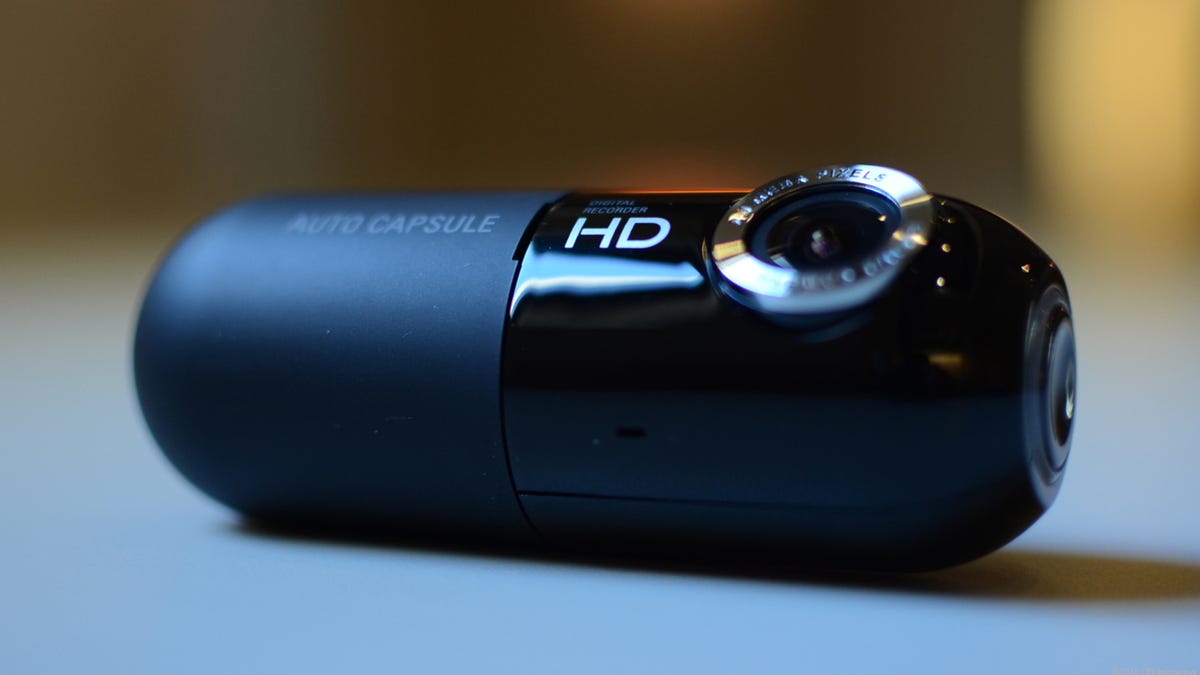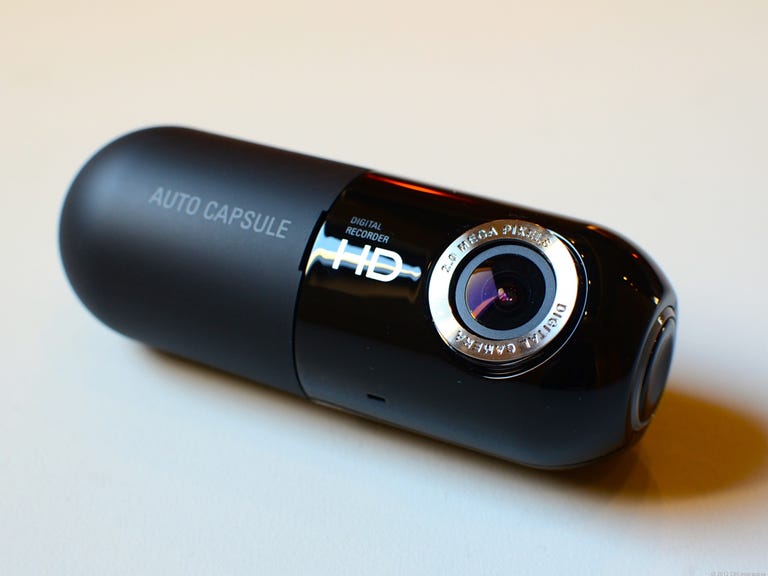 Why You Can Trust CNET
Why You Can Trust CNET Cowon Auto Capsule AC1 review: Cowon Auto Capsule AC1
This plug-and-play HD dashboard camera from Cowon automatically records any hazards or fender benders you may encounter on the road.
The Cowon Auto Capsule AC1 itself is a pill-shaped device that measures about 4 inches long and 1.5 inches around. The device is split into two halves that work independently of each other. At one end is a round button surrounded by an LED indicator and the AC1's 2-megapixel 720p camera. A removable door on this end hides a microSD card slot and a speaker. Meanwhile, at the other end of the device is a pair of connections for a 12-volt power adapter and an analog video output.
The Good
The Bad
The Bottom Line
The unit mounts to your car's dashboard or windshield with a plastic bracket that attaches via one of the two included adhesive pads. After mounting the unit, the AC1 is connected to your car's 12-volt power port with an included DC adapter. This cable is about 12 feet long, so you should have no trouble routing it around your windshield to your car's 12-volt power source. Cowon includes a trio of adhesive clips to help hold the cable in place.

The AC1 cannot be used without the power cable in place, but it holds enough residual charge when disconnected from power to finalize any video that it's currently recording and shut down.
When connected to power, the AC1 automatically powers on and settles into what is called real-time recording mode. In this state, the status LED surrounding the unit's only button glows blue and the device begins to maintain a video cache of its view out of your windshield. HD video is captured in a 16:9 format with a resolution of 1,280x720 pixels at a rate of 30 frames per second. The lens features a 150-degree field of view that is more than reasonably wide, keeping the entire front end of our test car (a 2013 Hyundai Genesis 5.0 R-Spec) in view. With its built in microphone, it can also record monaural audio, but don't expect the quality to be amazing.
Users can initiate a manual recording at any time by tapping the AC1's button, which causes the status LED to blink red. The 15 seconds of cached video preceding the button tap and the 15 seconds following will be stored on the microSD card as a 30-second AVI file.
However, the AC1's best party trick is its ability to automatically trigger video capture when its internal accelerometer detects a shock. So if you're driving along and the vehicle experiences a bump that the AC1 thinks is serious, it will automatically capture the 15 seconds of video preceding and following the event. Of course, this can lead to a number of false positives. At the end of my first test run, I found the SD card to be filled with videos capturing little more than potholes, hard starts to 0-60 runs, and aggressively tackled corners. However, I'm of the school of thought that it's better to have more footage than you need than not enough to protect yourself, so I didn't mind this.
< p>At the moment the AC1 is triggered (whether manually or automatically), the unit sounds a chime that is audible on the captured clip, making it easy to spot the moment of the event in question.
Attempts to purposely trigger the AC1's recording by slamming on the brakes, launching hard, and swerving aggressively to simulate collisions were successful. While the purpose of the captured video isn't to entertain your friends on the next movie night, I did find the quality of the captured clips to be acceptably good. The image was a bit fuzzy and colors slightly oversaturated, but these are hardly offenses.
While the AC1 is a ridiculously simple to use device, I did find that its instruction manual doesn't really go into great detail about some of the device's functions. For example, the Button Operation section alludes to a function called "Parking Mode Recording," but nowhere in the documentation is this feature actually explained. Likewise, the manual makes mention of the ability to stop and start the recording of sound, but doesn't explain how to do this.
Earlier, I made mention of a video output located on the same end of the unit as its power cable. Using the included 3.5mm to RCA video cable, the AC1 can be connected to a video source to display a live feed of its current capture. However, the included cable is too short to actually reach anything, and I'd recommend that you don't use this function while driving anyway.
When you're done recording, the captured footage can be downloaded to your computer by removing the microSD card from the AC1 camera, placing it into the included microSD to USB adapter, and connecting to your PC or Mac. Files are organized into four folders for Event Recordings, Manual Recordings, Motion Recordings, and Realtime Recordings.
The Auto Capsule AC1 kit includes PC software (on one of those weird 80mm mini CDs) for organizing and viewing the AVI files that it captures, but there is no included software for Mac. I'm not sure the tiny CD would fit any Mac device currently available anyway. (Note that the AVI format doesn't appear to be supported by Mac's QuickTime, iPhoto, or iMovie software, so you'll need to download a compatible video player, such as VLC, to view the AC1's captures.)
There's not much to the Cowon Auto Capsule AC1. It's a camera that records HD video of reasonable quality automatically while you drive. It's an electronic eye that's always watching your back. (Well, literally, it's watching your front, but I digress.) The only way that I could think to improve this camera is to include a GPS sensor and the ability to store location and speed metadata alongside the video. However, less can be more and the simple, yet effective AC1's no-thought, idiot-proof design turns out to be its greatest asset.
However, at $199, it is also a bit expensive. Those who take the time to shop around could easily find competing models for as much as half off the Cowon AC1's MSRP.


